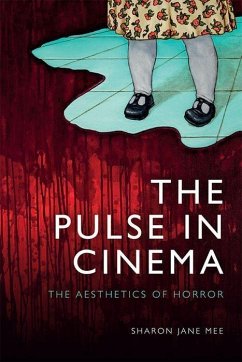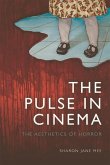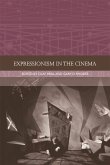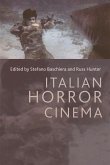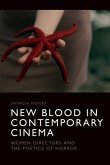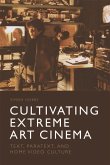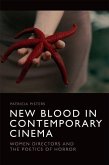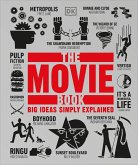- Gebundenes Buch
- Merkliste
- Auf die Merkliste
- Bewerten Bewerten
- Teilen
- Produkt teilen
- Produkterinnerung
- Produkterinnerung
The Pulse in Cinema acknowledges that the pulse is "felt" in the body, yet also argues that the pulse has a wider reaching effect in cinema than simply the physiological response of the spectator to the image it's the affective force in cinema.
Andere Kunden interessierten sich auch für
![The Pulse in Cinema The Pulse in Cinema]() Sharon Jane MeeThe Pulse in Cinema30,99 €
Sharon Jane MeeThe Pulse in Cinema30,99 €![Expressionism in the Cinema Expressionism in the Cinema]() Olaf BrillExpressionism in the Cinema38,99 €
Olaf BrillExpressionism in the Cinema38,99 €![Italian Horror Cinema Italian Horror Cinema]() Italian Horror Cinema38,99 €
Italian Horror Cinema38,99 €![New Blood in Contemporary Cinema New Blood in Contemporary Cinema]() Patricia PistersNew Blood in Contemporary Cinema30,99 €
Patricia PistersNew Blood in Contemporary Cinema30,99 €![Cultivating Extreme Art Cinema Cultivating Extreme Art Cinema]() Simon HobbsCultivating Extreme Art Cinema38,99 €
Simon HobbsCultivating Extreme Art Cinema38,99 €![New Blood in Contemporary Cinema New Blood in Contemporary Cinema]() Patricia PistersNew Blood in Contemporary Cinema112,99 €
Patricia PistersNew Blood in Contemporary Cinema112,99 €![The Movie Book The Movie Book]() DKThe Movie Book17,99 €
DKThe Movie Book17,99 €-
-
-
The Pulse in Cinema acknowledges that the pulse is "felt" in the body, yet also argues that the pulse has a wider reaching effect in cinema than simply the physiological response of the spectator to the image it's the affective force in cinema.
Hinweis: Dieser Artikel kann nur an eine deutsche Lieferadresse ausgeliefert werden.
Hinweis: Dieser Artikel kann nur an eine deutsche Lieferadresse ausgeliefert werden.
Produktdetails
- Produktdetails
- Verlag: Edinburgh University Press
- Seitenzahl: 216
- Erscheinungstermin: 31. Oktober 2020
- Englisch
- Abmessung: 163mm x 240mm x 22mm
- Gewicht: 498g
- ISBN-13: 9781474475846
- ISBN-10: 1474475841
- Artikelnr.: 59504858
- Herstellerkennzeichnung
- Libri GmbH
- Europaallee 1
- 36244 Bad Hersfeld
- gpsr@libri.de
- Verlag: Edinburgh University Press
- Seitenzahl: 216
- Erscheinungstermin: 31. Oktober 2020
- Englisch
- Abmessung: 163mm x 240mm x 22mm
- Gewicht: 498g
- ISBN-13: 9781474475846
- ISBN-10: 1474475841
- Artikelnr.: 59504858
- Herstellerkennzeichnung
- Libri GmbH
- Europaallee 1
- 36244 Bad Hersfeld
- gpsr@libri.de
Dr Sharon Jane Mee is Adjunct Lecturer in Screen Studies at the University of New South Wales.
Acknowledgements
List of Illustrations
Introduction
Rosalind E. Krauss's Theory of the Pulse
Rhythm and Pulse
The Pulse: A Philosophical Enquiry
Body Horror
1. The Rhythm of Life: The Pulse in the Image
Rhythm and Pulse
Rhythm in Experimental Cinema
1. American Avant-garde and the Structuralist/Materialists
2. The French Impressionists
3. Dada
Protocinema: Étienne-Jules Marey
The Pulse in Psychoanalysis: Sigmund Freud
2. The Rhythm of Life: The Pulse in the Spectator
Surfaces of Inscription and Passages of Intensity
Movement, and an Opening
The Logic of Sensation as a Diastolic-systolic Opening
The Aesthetics of the Open: Georges Franju's Le Sang des bêtes/Blood of the
Beasts (1949)
A Libidinal Economy, and an Opening
Candour as the Body's Openness to an Outside
3. Aisthesis and Dispositif: The Pulse and its Analogues
Extracting the Fear that Tingles the Spine: The Hype, the Buzz of the
Gimmick, and the Bottom Line
The Execution: The Tingler (1959)
Aisthesis and Prescribed Lines
Prescription and the Aesthetics of Blood Spilled
The Pulse 'Exposed'
Dispositif: Lines of Fright
Figural Analogues or 'a Metonymy Without End': The Heart that Throbs, the
Spine that Tingles, the Mouth that Screams. Do you have the Guts?
4. Automutilation and Metonymy: The Economy of the Pulse
General Economy as Energetic Expenditure
Two General Economies of Communication and Communion
1. Automutilation: Effects on the Flesh
2. Metonymy and the 'Operation' to Undo Identity
Automutilation and George A. Romero's Dawn of the Dead (1978)
An Operation in the Morgue: Lucio Fulci's L'aldilà/The Beyond (1981)
The Sovereign Operation as Affective Experience
The Pulse as a Sovereign Operation in Horror Cinema
5. Blood and Convulsive Affect: Vectors of the Pulse as Sovereign
Operations
Andrzej Zulawski's Possession (1981)
Possession and Dispossession
Body Horror and Convulsive Affect
The Copula and the Copulation of Bodies: The Convulsions of Language and
Self, Even (Fucking Language)
The Movement-Image and Vectors of Sensation
The Machinic and the Non-Machinic
The Vector and Communication
The Magnitude and Direction of Vectors that Result in Possession and
Dispossession
Material Vectors and their (Non)sense
Bibliography
Filmography
Index.
List of Illustrations
Introduction
Rosalind E. Krauss's Theory of the Pulse
Rhythm and Pulse
The Pulse: A Philosophical Enquiry
Body Horror
1. The Rhythm of Life: The Pulse in the Image
Rhythm and Pulse
Rhythm in Experimental Cinema
1. American Avant-garde and the Structuralist/Materialists
2. The French Impressionists
3. Dada
Protocinema: Étienne-Jules Marey
The Pulse in Psychoanalysis: Sigmund Freud
2. The Rhythm of Life: The Pulse in the Spectator
Surfaces of Inscription and Passages of Intensity
Movement, and an Opening
The Logic of Sensation as a Diastolic-systolic Opening
The Aesthetics of the Open: Georges Franju's Le Sang des bêtes/Blood of the
Beasts (1949)
A Libidinal Economy, and an Opening
Candour as the Body's Openness to an Outside
3. Aisthesis and Dispositif: The Pulse and its Analogues
Extracting the Fear that Tingles the Spine: The Hype, the Buzz of the
Gimmick, and the Bottom Line
The Execution: The Tingler (1959)
Aisthesis and Prescribed Lines
Prescription and the Aesthetics of Blood Spilled
The Pulse 'Exposed'
Dispositif: Lines of Fright
Figural Analogues or 'a Metonymy Without End': The Heart that Throbs, the
Spine that Tingles, the Mouth that Screams. Do you have the Guts?
4. Automutilation and Metonymy: The Economy of the Pulse
General Economy as Energetic Expenditure
Two General Economies of Communication and Communion
1. Automutilation: Effects on the Flesh
2. Metonymy and the 'Operation' to Undo Identity
Automutilation and George A. Romero's Dawn of the Dead (1978)
An Operation in the Morgue: Lucio Fulci's L'aldilà/The Beyond (1981)
The Sovereign Operation as Affective Experience
The Pulse as a Sovereign Operation in Horror Cinema
5. Blood and Convulsive Affect: Vectors of the Pulse as Sovereign
Operations
Andrzej Zulawski's Possession (1981)
Possession and Dispossession
Body Horror and Convulsive Affect
The Copula and the Copulation of Bodies: The Convulsions of Language and
Self, Even (Fucking Language)
The Movement-Image and Vectors of Sensation
The Machinic and the Non-Machinic
The Vector and Communication
The Magnitude and Direction of Vectors that Result in Possession and
Dispossession
Material Vectors and their (Non)sense
Bibliography
Filmography
Index.
Acknowledgements
List of Illustrations
Introduction
Rosalind E. Krauss's Theory of the Pulse
Rhythm and Pulse
The Pulse: A Philosophical Enquiry
Body Horror
1. The Rhythm of Life: The Pulse in the Image
Rhythm and Pulse
Rhythm in Experimental Cinema
1. American Avant-garde and the Structuralist/Materialists
2. The French Impressionists
3. Dada
Protocinema: Étienne-Jules Marey
The Pulse in Psychoanalysis: Sigmund Freud
2. The Rhythm of Life: The Pulse in the Spectator
Surfaces of Inscription and Passages of Intensity
Movement, and an Opening
The Logic of Sensation as a Diastolic-systolic Opening
The Aesthetics of the Open: Georges Franju's Le Sang des bêtes/Blood of the
Beasts (1949)
A Libidinal Economy, and an Opening
Candour as the Body's Openness to an Outside
3. Aisthesis and Dispositif: The Pulse and its Analogues
Extracting the Fear that Tingles the Spine: The Hype, the Buzz of the
Gimmick, and the Bottom Line
The Execution: The Tingler (1959)
Aisthesis and Prescribed Lines
Prescription and the Aesthetics of Blood Spilled
The Pulse 'Exposed'
Dispositif: Lines of Fright
Figural Analogues or 'a Metonymy Without End': The Heart that Throbs, the
Spine that Tingles, the Mouth that Screams. Do you have the Guts?
4. Automutilation and Metonymy: The Economy of the Pulse
General Economy as Energetic Expenditure
Two General Economies of Communication and Communion
1. Automutilation: Effects on the Flesh
2. Metonymy and the 'Operation' to Undo Identity
Automutilation and George A. Romero's Dawn of the Dead (1978)
An Operation in the Morgue: Lucio Fulci's L'aldilà/The Beyond (1981)
The Sovereign Operation as Affective Experience
The Pulse as a Sovereign Operation in Horror Cinema
5. Blood and Convulsive Affect: Vectors of the Pulse as Sovereign
Operations
Andrzej Zulawski's Possession (1981)
Possession and Dispossession
Body Horror and Convulsive Affect
The Copula and the Copulation of Bodies: The Convulsions of Language and
Self, Even (Fucking Language)
The Movement-Image and Vectors of Sensation
The Machinic and the Non-Machinic
The Vector and Communication
The Magnitude and Direction of Vectors that Result in Possession and
Dispossession
Material Vectors and their (Non)sense
Bibliography
Filmography
Index.
List of Illustrations
Introduction
Rosalind E. Krauss's Theory of the Pulse
Rhythm and Pulse
The Pulse: A Philosophical Enquiry
Body Horror
1. The Rhythm of Life: The Pulse in the Image
Rhythm and Pulse
Rhythm in Experimental Cinema
1. American Avant-garde and the Structuralist/Materialists
2. The French Impressionists
3. Dada
Protocinema: Étienne-Jules Marey
The Pulse in Psychoanalysis: Sigmund Freud
2. The Rhythm of Life: The Pulse in the Spectator
Surfaces of Inscription and Passages of Intensity
Movement, and an Opening
The Logic of Sensation as a Diastolic-systolic Opening
The Aesthetics of the Open: Georges Franju's Le Sang des bêtes/Blood of the
Beasts (1949)
A Libidinal Economy, and an Opening
Candour as the Body's Openness to an Outside
3. Aisthesis and Dispositif: The Pulse and its Analogues
Extracting the Fear that Tingles the Spine: The Hype, the Buzz of the
Gimmick, and the Bottom Line
The Execution: The Tingler (1959)
Aisthesis and Prescribed Lines
Prescription and the Aesthetics of Blood Spilled
The Pulse 'Exposed'
Dispositif: Lines of Fright
Figural Analogues or 'a Metonymy Without End': The Heart that Throbs, the
Spine that Tingles, the Mouth that Screams. Do you have the Guts?
4. Automutilation and Metonymy: The Economy of the Pulse
General Economy as Energetic Expenditure
Two General Economies of Communication and Communion
1. Automutilation: Effects on the Flesh
2. Metonymy and the 'Operation' to Undo Identity
Automutilation and George A. Romero's Dawn of the Dead (1978)
An Operation in the Morgue: Lucio Fulci's L'aldilà/The Beyond (1981)
The Sovereign Operation as Affective Experience
The Pulse as a Sovereign Operation in Horror Cinema
5. Blood and Convulsive Affect: Vectors of the Pulse as Sovereign
Operations
Andrzej Zulawski's Possession (1981)
Possession and Dispossession
Body Horror and Convulsive Affect
The Copula and the Copulation of Bodies: The Convulsions of Language and
Self, Even (Fucking Language)
The Movement-Image and Vectors of Sensation
The Machinic and the Non-Machinic
The Vector and Communication
The Magnitude and Direction of Vectors that Result in Possession and
Dispossession
Material Vectors and their (Non)sense
Bibliography
Filmography
Index.

